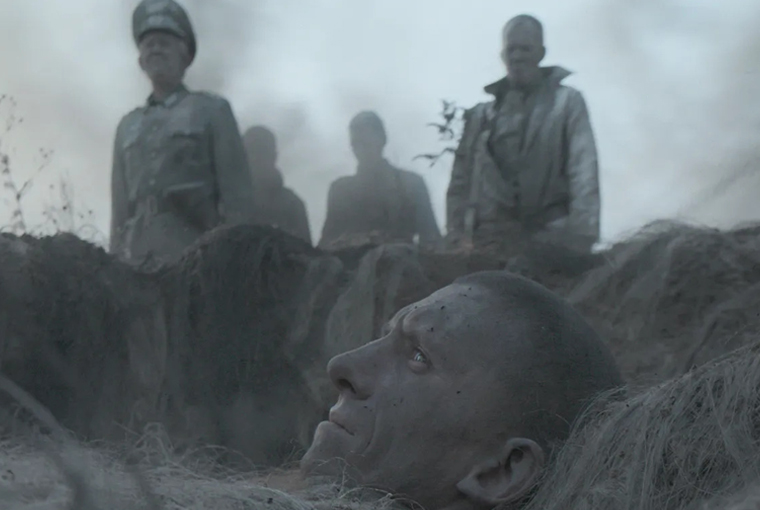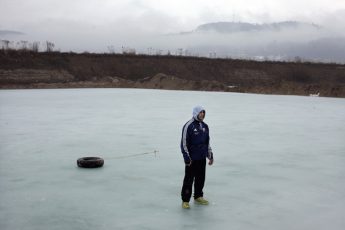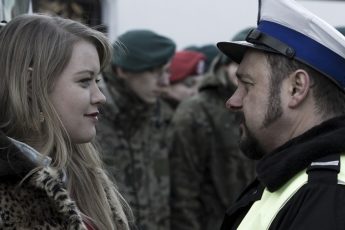The Wicked Flee When No Man Pursueth
Maria Ignatenko’s Achrome (Pryzrachno-belyi, 2022)
Vol. 121 (January 2022) by Jack Page
Set in the bleak backwoods of the Baltic states during WWII, an impressionable young man named Maris leaves his family’s village to enlist in the Wehrmacht. Drafted along with his brother, they journey through an eerie forest – a ghost world – in seek of their barracks. A new life in the military is far from the idealistic dreams they once whispered to their mother back in the safety of their thatched cottage home. Their base is located in an active monastery, an ironic space given the ungodly images Maris will witness there. As told from Maris’ point of view, the horrors of war quickly reveal themselves in his everyday reality and the man is soon convinced that his voluntary act to join the army was the biggest mistake of his short life.
The mise-en-scène and iconography of Ignatenko’s feature appears to be heavily influenced by the aesthetics of Tarkovsky’s Ivan’s Childhood and Sokurov’s Mother & Son. At one point, our protagonist is carried in his brother’s arms through the foggy wilderness as a voiceover retells memories of their youth together. The thin trees tower into the grey heavens above and their figures disappear into the ethereal space between the branches. Even the monochrome palate of the film embodies an almost tangible sense of melancholia on screen. The exterior sequences of Achrome resemble fever dreams, brimming with soft focus and meticulously staged cinematography. The camera’s transient nature is evoked by detaching itself from the characters through its rigid, handheld routine. The setting is both idyllic and nightmarish. The naturalistic staging of events – the vast woodland, the quaint farm, the sinister church – are twisted into a haunting visage of the pastoral. Homes are deserted and smoky skies are filled with the ash of burnt buried victims, like an uncanny mirroring of a hellish landscape.
In the mess hall a hungry dog eats among the German soldiers. The bestial sounds emanating from the hound are echoed by the guffaws and animalistic manners of the men. The men drool and growl as they feast, spilling their plates and stuffing their faces. It is a clear debasement of the soldiers, comparing their ferocity in appetite and sexual deviancy with that of the dirty mongrel. One particular solider violently kisses a captured woman, who herself is drunk. It is one of the fastest paced sequences in the film, cutting swiftly between medium shots of the soldier’s revolting etiquette and close-ups of the mutt devouring its supper. The editing is so obtuse that the blending of these scenes and their carnal images is overwhelming in its change of pace for the spectator. It bombards the viewer with its dynamism, dizzying and titillating, a perfect device that evokes the same guttural sense of nausea from the screen to its audience.
The final scene of the film encapsulates filmmaker Ignatenko’s ideology in a simplistic and succinct set up. Down by a dugout, where upended trees lay with their roots exposed, sits a pit filled with a number of dead women. Their lifeless bodies are awkwardly strewn amongst the dirt, mud and grit staining their once pure white dresses. Their pale limbs liken the fallen, grey branches scattered in the background. This brutal and macabre tableau is infringed upon by an approaching group of soldiers. The eager men rummage through the ditch, manhandling the bodies. Breaking the fourth wall, they pose with the deceased, forcing the women into making lewd gestures and smirking directly into the camera. Their childlike glee and immaturity make the act all the more harrowing, exacerbated further by the extended duration of the take. The sheepish Maris (played by Georgiy Bergal) emerges from the small crowd of soldiers, unwilling to join the men’s misdeeds. He is literally taken by the hand and forced to touch and pose with the corpses. However coerced or bullied, the innocent witness becomes a participant. This moment when Maris becomes an accomplice to the heinous display is freezeframed. When the screen abruptly cuts to black, the diegetic sound continues to play over the credits. While the image of Maris fondling the deceased lasts only momentarily, it is his accountability that lingers, like the ambient noise of the whistling wind and shuffling of solder’s feet. In the same way, the repercussions of past historical crimes continue to exist in the present. A nation’s gnawing guilt and shame outlive the heinous actions of the collaborating citizens in a Nazi-occupied Baltic state during World War II.
Achrome’s dispiriting conclusion illustrates that in Maris’ world – as in our own – there is no turning back, no opportunity to repent. Even by surrendering himself to his own moral and ethical undoing, he is still a witness to the atrocity that surrounds him. But if he is not part of the solution, he is part of the problem. Director Maria Ignatenko makes an example out of Maris: the man who turns his head the other way has the same culpability as the man who pulls the trigger.




Leave a Comment